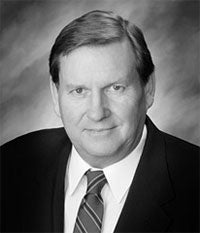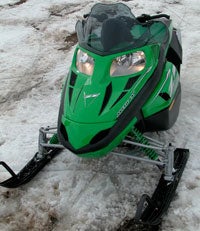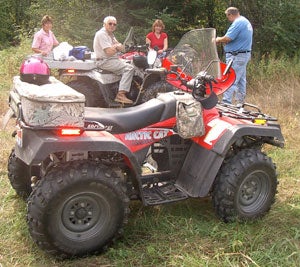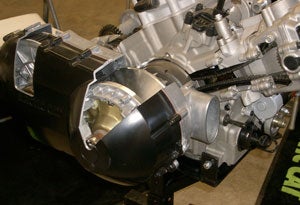Knowing “The” Ole Tweet

Tweet devoted a career to letting us enjoy Arctic Cat brand vehicles
One of the advantages of being a senior snowmobile writer comes in meeting so many interesting characters and great people over the years. If you last in the business long enough by failing to do the right thing and simply fading away, you get to cross paths with the same characters time and time again. As your career winds down, you will have watched some of these characters rise to a level of success simply by trying to their best at each task they attempted. And, then there is the day an event prods your memories and you reflect on having known some quite remarkable characters.
When the announcement that Ole Tweet was preparing to retire from Arctic Cat burned across my computer screen, I read something quite remarkable in a corporate press piece. Instead of the typical basic, short and matter-of-fact “PR” reportage, this Arctic Cat missive conveyed respect, admiration and a genuine sadness that the man was reducing his role in the company.

Ole Tweet the man was owed this respect. He certainly earned it.
As a young associate editor for a snowmobile business magazine, part of my job was to input news of recently hired industry people, promotions, gatherings and such. Because I was new to the American Midwest, especially the Scandinavian and Germanic traditions of Minnesota, I saw the name Ole Tweet and smiled, knowing that such a name certainly would stand out in my native New England, home to French, Italian and English surnames. To me Ole was a name you heard in “Ole & Lena” jokes, popular in Minnesota. Ironically, as I got to know the flesh and blood Ole Tweet, I would discover that he had quite a knowledge of such stories. The man has a wonderful sense of humor, subtle often, but well developed.
The Old Cat
That entry of Ole’s name in the pages of snowmobile business history came back in 1977. He had been hired on as a young engineer at the “original” Arctic Cat. He would establish serious roots in Thief River Falls, Minn., where he still lives. Fortunately he married well as his wife Ruth was left alone frequently with a growing brood. As life would have it, Ole would be gone a great deal.
Up to the end of the “original” Arctic Cat, Ole’s lot was like many young engineers. He moved ahead, enjoyed his job and probably looked ahead to a nicely defined career. That s-o-o didn’t happen. Circumstances redefined his career in 1981 when his three-year reign as Arctic Cat “head of engineering” ended. Post 1981 Ole became a snowmobile company paramedic. He was one of a small internal group of Arctic Cat survivors determined to save the snowmobile portion of the company.
Years before Arctic Enterprises fell into bankruptcy, the company had used its snowmobile success to diversify into boats. For Minneapolis-based Irwin Jacobs, the boat businesses were attractive. Not so much the sled biz. All of that literally went up for bids and Ole Tweet and the small “new” Arctic Cat group tried to buy pieces that could get them back to being a viable, though very small player in snowmobiling.
No Cat, No Snowmobiling
 During Ole Tweet’s career-span Arctic Cat’s snowmobile product went from leafsprung sleds to the latest rider forward Z1.
During Ole Tweet’s career-span Arctic Cat’s snowmobile product went from leafsprung sleds to the latest rider forward Z1.
Amazingly, Arctic Cat brand snowmobiles came with such a cachet that some owners would exit the sport rather than ride another brand. Ah, that can’t be true you say? One of my editorial jobs at this time was to work at night surveying a number of magazine subscribers who owned Arctic Cats. Conducting those interviews showed how intensely intertwined the “image” of Arctic Cat was with its riders.
More than an engineer, Tweet recognized and understood this synergy. Plus, before the bankruptcy, Arctic Cat had been the Number One selling sled brand, meaning simply that if the “new” Cat could get enough time to bring a new design to market, then there could be a future.
In some ways the circumstances that forced the old Arctic Cat into bankruptcy actually worked for the “new” Arctic Cat team. Sled sales were stagnant. New designs weren’t really coming online at a pace to severely outdate models Arctic Cat could bring to market. That’s why the first “new” Arctic Cats were actually new “old” versions of the Panther and a leaf sprung performance model. With the help of Suzuki as engine supplier, Arctic Cat began an arduous come back.
Guerilla Marketing
 Tweet understood that part of the Arctic Cat success centered around blending product with loyal customers.
Tweet understood that part of the Arctic Cat success centered around blending product with loyal customers.It was here that our paths crossed. Ole Tweet was now “vice president of marketing,” someone had to be, so Ole took the job. I remember him coming to our St. Paul, Minn. offices looking to barter a deal for snowmobile advertising. Our snowmobile publication was the largest of its day. We reached more than one million snowmobile owners with our issues; of course he wanted to get his message out to that readership.
Those first advertisements were basic and simply announced little more than the “The Cat Is Back.” But some how our state-of-the-art printing facility managed to “mess” up the ads and Ole got a “make-good” in the next issue. Basically he wangled two-for-one pricing.
In those days all Ole Tweet and the “new” Arctic Cat wanted was to grow a 10 percent share of a sled market that had smaller sales than we do now. In 1992 sled sales were 150,000. Five years later the market grew to 260,000 annual sales and things were very good at the “new” Arctic Cat, known as Arctco. While the new Cat team could get manufacturing pieces to restart a sled line, they failed to get the rights to the Arctic Cat name and had to pay a royalty for the right to use some brand names. That problem has long since gone away, but it was a point of concern back then.
Beyond Expectations
 Innovation in power and speed was an Arctic Cat trademark for sleds and ATVs.
Innovation in power and speed was an Arctic Cat trademark for sleds and ATVs.Years later, when we visited Thief River Falls and had a private tour of the facility with Ole, we couldn’t help but ask him if he had ever expected things to go so well for Arctic Cat? “No,” was his answer. In typical Ole Tweet fashion he left it at that. Perhaps that’s why I’ve enjoyed knowing Ole Tweet the man as much as I have. He’s an easy person to admire and respect. He’s smart. He has an incredible work ethic. He’s matter-of-fact practical but engineering inventive.
If you met Ole Tweet at The Black Cat Grill in Thief River Falls, you’d only know that he was associated with Arctic Cat because of the personal recognition he tends to receive from local folks. Ole wouldn’t tell you all that he accomplished. As Arctic Cat chairman Chris Twomey would point out, “Ole would be the first to deflect any personal praise and say that he was just one of many. But I’m here to tell you that Ole has truly been one of the most influential and important.” Twomey was there in the early years, too. He knows how things went down.
Over the years Ole Tweet has devoted much to the success of the Arctic Cat revival. He launched the personal watercraft side and he was instrumental in the ATV side of the company as well.
Perhaps it’s unfair of me to state that Ole Tweet is retiring. He will continue to represent Arctic Cat in industry associations and share in corporate governance. But for a man wired like Ole Tweet that is pretty much retirement. As much for any man who has Cat green blood flow through his veins. There are many who know well how much this man has meant to Arctic Cat — sled or ATV. He earned his way.
Related Reading Arctic Cat ATV GM Ole Tweet retires








 Your Privacy Choices
Your Privacy Choices